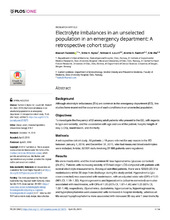| dc.description.abstract | Background: Although electrolyte imbalances (EIs) are common in the emergency department (ED), few studies have examined the occurrence of such conditions in an unselected population. Objectives: To investigate the frequency of EI among adult patients who present to the ED, with regards to type and severity, and the association with age and sex of the patient, hospital length of stay (LOS), readmission, and mortality. Methods: A retrospective cohort study. All patients ≥18 years referred for any reason to the ED between January 1, 2010, and December 31, 2015, who had measured blood electrolytes were included. In total, 62 991 visits involving 31 966 patients were registered. Results: EIs were mostly mild, and the most common EI was hyponatremia (glucose-corrected) (24.6%). Patients with increasing severity of EI had longer LOS compared with patients with normal electrolyte measurements. Among all admitted patients, there were 12928 (20.5%) readmissions within 30 days from discharge during the study period. Hyponatremia (glucose-corrected) was associated with readmission, with an adjusted odds ratio (OR) of 1.25 (95% CI, 1.18–1.32). Hypomagnesemia and hypocalcemia (albumin-corrected) were also associated with readmission, with ORs of 1.25 (95% CI, 1.07–1.45) and 1.22 (95% CI, 1.02–1.46), respectively. Dysnatremia, dyskalemia, hypercalcemia, hypermagnesemia, and hyperphosphatemia were associated with increased in-hospital mortality, whereas all EIs except hypophosphatemia were associated with increased 30-day and 1-year mortality. Conclusions: EIs were common and increasing severity of EIs was associated with longer LOS and increased in-hospital, 30-days and 1-year mortality. EI monitoring is crucial for newly admitted patients, and up-to-date training in EI diagnosis and treatment is essential for ED physicians. | en_US |

